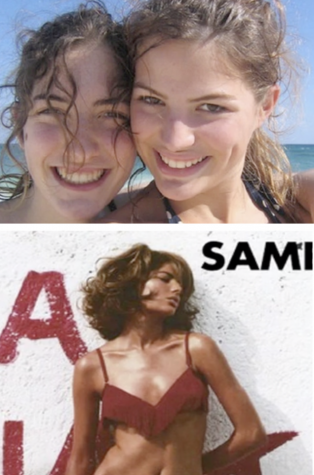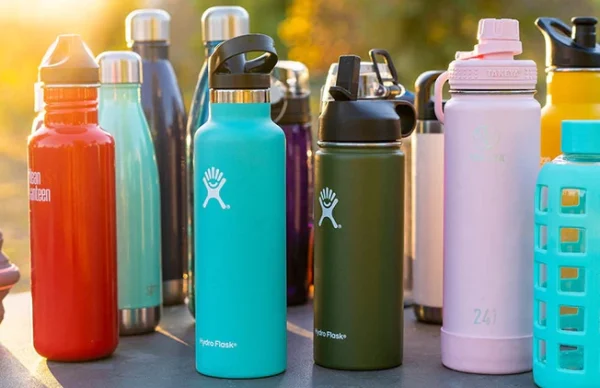The Picture Beyond The Filter: Inside the World of Superficial Image
Some of the many photos that can be found across social media that might be dangerous to the self-confidence of others. Courtesy of socialmediaexaminer.com and Pinterest.
May 18, 2020
In recent years, social media has not necessarily been the nicest towards me. However, our relationship wasn’t always this way; back in middle school, social media started out my friend, filling my feed with pictures of camp friends I rarely had the chance to see and baking videos that made me wish I actually was a decent baker. I respected social media for helping me stay in touch with my close friends and helping me learn more information about politics, cultures, and new ideas. But suddenly, social media started working against me; it began to fill my feed with pictures of beautiful models, beautiful places, and beautiful clothes I could never buy. How could this happen, and why did this change so drastically? And, more importantly, why did I want to be these people and own these things so badly? The pictures deteriorated my self-respect, confidence, and happiness. I knew that social media was extremely toxic and detrimental to my health, but I thrived on the addiction. I continued to spend hours upon hours looking at pictures of beautiful models and whimsical places, knowing that I was only feeding my anxiety and destroying the love I once had for myself. Eventually, it reached the point where I felt that even validation from my own friends or loved ones was not worth it; every choice I made in my life correlated to the beautiful pictures I saw on social media. “You need to lose more weight because you need to be like those models.” “You need to change your hair because lighter blondes are prettier.” “You need to buy these clothes because more people will respect you.” All of these terrible thoughts never left my mind. They formed gaping holes in my heart and my mind, leaving gloomy imprints on every memory I had throughout my teenage years. Thankfully, I saw the light at the end of the tunnel. I realized I didn’t have to be like this. I needed to feel good about myself on my own, without the worry about what people would say – I needed to love and care for myself first. So, I picked myself up, wiped the tears from my eyes, put down the phone, and took control of my life for the first time in many years.
Personally, I felt that it would help me on the road to recovery to find other people who experienced the same thoughts I had. While I turned to my mom and other loved ones in my life, I ironically also turned to the place that had also caused most of my pain: the Internet. I began to spend my free time searching for seminars and presentations about the significance of self-love and empowerment, watching videos about women and men who had endured the same pain I had. It was while searching through these videos that I came across a woman that changed my life: Cameron Russell.
While I did not know anything about Cameron or had even heard her name before watching her Ted Talk, I immediately became fascinated by her. From the first few seconds into the video, I could tell by her short black dress, tan skin, and long legs that she was a model. I clicked on this video because I needed empowerment – how was a model going to help me? But then, Cameron took a sudden turn during the opening segment of her presentation: she changed her entire wardrobe. She switched from her high heels and short black dress to a long skirt and flats, covering her olive skin and beautiful features. She laughed as if she was embarrassed to be changing in front of hundreds of people, which was ironic considering that she had probably changed in front of hundreds of people during shoots and fashion shows. After she had finished awkwardly changing, Cameron suddenly proposed a question: “Now why did I do that?” The room once momentarily filled with uncomfortable laughter became solemn and suspenseful, and, like the people in the audience, I became hooked to the presentation.
Cameron elaborated on the question she had just proposed, stating she changed her outfit to prove that changing your image or your style can immediately change the way people view your appearance or personality – a strategy often used by corporations or platforms to attract consumers and attack viewers. However, Cameron said, behind many of these photos, the image showed a completely different representation of an individual or an object; it was the superficial reflection of a more-than-glamorous life. Furthermore, she claimed that these superficial images were actually more harmful to the people depicted, mostly because the pictures exaggerated their age, beauty, or sex appeal. She was well-versed to the dangers of these superficial images, she stated, because she had endured the effects.

Cameron began modeling when she was only 13, jet setting around the world to model for well-known magazines and walk for prominent designers during Fashion Week. Throughout her career as a young teenager, however, she felt she was almost living a double life – one where she modeled for top brands, and one where she lived like a regular teenager. To prove her point, Cameron began to put up side-by-side comparisons of her modeling and her doing normal activities as a teenager, usually taken only hours apart from one another. One particular set of these pictures grasped my attention. On the left was a picture of Cameron at 15, modeling in a stunning crimson bathing suit for Vogue. Her hair was blown out, her skin looked unusually shiny, and she gave a subtle pout that made her pose look absolutely flawless. She looked well beyond her years, like a poised and elegant woman with a beautiful and youthful glow. On the right was a picture of Cameron taken only a few hours after her Vogue shoot, standing next to her friend at the beach taking a quick selfie. Her hair was tangled from swimming, her skin raw from the salty water, and she smiled so wide that you couldn’t help but notice her pearly white teeth. This – she concluded – was the danger of superficial image. It took away her childhood, her ability to enjoy being a teenager. Rather than swimming with her friends or spending time with her family, she spent her days flaunting her body for the cameras, made to look like a mature woman – not a girl who wasn’t even old enough to have her first period yet. The photos deteriorated her confidence and her self-respect, the same way that they had destroyed me. She then said that the average person wouldn’t think that models would be self-conscious; however, they were possibly the most. I knew it wasn’t an excuse to show empathy for the people that had caused most of my pain, but it was a symbol to show that a superficial image can bring the same pain to everyone, regardless of our body types or our physical features. Superficial images give us the chance to escape from reality, the ability to decide what kind of image we want others to see. What we fail to realize, however, is that we can also be the ones creating these images in hopes of harming others. Models do what they do because it is their job to post pictures from their career portfolio; they don’t truly intend to harm people, but some fail to realize that their beauty can be the most damaging effect on the lives of younger girls or boys. Sadly, we also never know how many of these models feel about or cope with the dangers of superficial images. Their pictures can show so much happiness and enjoyment, but behind them, they can reveal pain and suffering.
Cameron’s video inspired me to love myself and become more cautious about social media. I learned that if I leaned away from superficial images and developed a better relationship with social media, I could also learn to distance myself from it. I learned to limit my time on social media, spending more time doing things that brought joy to my life, such as reading, playing lacrosse, and spending time with my family. While I knew I would never have the same relationship with social media I once had back in middle school, I promised to myself that I would try to mend the relationship as long as it helped me with my recovery. And while I understood that these superficial images were pretty much unavoidable, I would simply have to keep reminding myself that I did what I did because it made me happy.
I am proud to say that my mission was a success; I stopped putting up pictures that made me think twice about how it would be portrayed or accepted by my followers. I began to fill my feed with quotes, pictures, and videos that truly captured my interest, ridding it of all the luxury items I could never afford and models plugging weight-loss supplements and expensive acne-removal treatments. For the first time in a long time, I was using social media for myself, putting up pictures that made me feel proud of myself and my life. Like Cameron had said in the video, she had become a model because she had won a genetic lottery that was embraced by society – but that didn’t mean that everyone else had lost. Everyone else was truly beautiful, and they deserved to be recognized the same way. I am not a model, and probably will never be one, but I know that I am beautiful. And I know that I will never have to change who I am to have other people see that.














